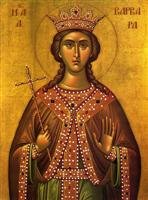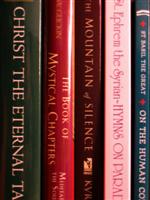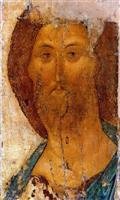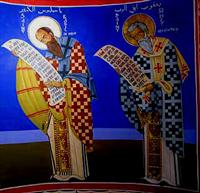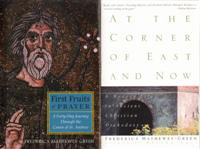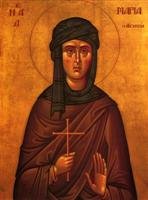 In the Western world, anthropology is the name given to the academic “study of humanity.” It’s a broad field divided into several specific areas of study like cultural anthropology, linguistic anthropology, archaeology, and biological anthropology.
In the Western world, anthropology is the name given to the academic “study of humanity.” It’s a broad field divided into several specific areas of study like cultural anthropology, linguistic anthropology, archaeology, and biological anthropology.I’ve learned much about different cultures and religions through my formal American education, but I never really grasped the nature of humanity until I understood the anthropology of the (Eastern) Orthodox Christian Church, the most ancient Church in the world. Unfortunately, many Americans misunderstand both humanity as a whole and themselves in particular both because of their socialization in secular Western culture as well as the rationalist, academic approach to humanity championed in American education.
Orthodox Christian anthropology is not a Western, secular, academic study, but a way of understanding humanity with roots in the mystical spirituality of the Christian East. The knowledge contained within Orthodox Christian anthropology isn’t a collection of objective data collected by scientific means, evaluated, and turned into theories to explain certain aspects of human existence. Scientific inquiry is concerned with what can be investigated with the senses, tested, and measured. Orthodox Christian anthropology involves spirituality, real spirituality. Spirituality is our relationship with the Creator, in whose image we have been made. Our created existence is intertwined with the eternal God who is without beginning and end. Who knows more about humanity than the One who made us and breathed into us the breath of life? If we want to know about ourselves, we need to know our Creator (not just know about Him intellectually, but know Him experientially). The Infinite One has created the universe and endowed humanity with the reason and skill to scientifically explore His creation, but while we can investigate what God has made with scientific methods, science can’t study God Himself. We can only know about God what He reveals to us. Likewise, we can only deeply know ourselves by discovering what God has shown us.
Some people may imagine that God lives distantly beyond the universe, “up there somewhere.” That’s a tremendous misunderstanding. The transcendent One who cannot be comprehended or contained by the universe and brought all things into existence has been present and actively working within the world since the beginning. Throughout human history our Creator has revealed Himself to us and showed us what it means to be human. Orthodox Christian anthropology, then, is concerned with the knowledge that our Creator has revealed to humanity about what it means to be human, who we were in the distant past, who we are now, and who we are capable of becoming.
One of the problems with secular anthropology as taught in Western colleges is that the subject ignores or denies the Creator who possess all knowledge about us. As long as ignorance of God permeates the field, anthropology will never be able to adequately explain who we were in our primitive state, who we have become, or what we can achieve. Secular anthropology is ill-equipped to explain what it means to be truly human.
For almost two thousand years, the Orthodox Christian Church has preserved the sacred, divinely-revealed knowledge of true anthropology. While Christ established the Church in the first century AD, the spiritual story of the Church and the sacred knowledge it protects extends far back through 4,000 years of recorded human history to Mesopotamia, and back farther still to the beginning when our first ancestors came into being.
This sacred knowledge about humanity is kept within Holy Tradition, the ancient Faith inseparably infused with a complete spiritual lifestyle that has been lived by Orthodox Christians generation after generation since the time of the Apostles. Every generation is entrusted to protect the way of life handed down to them by their ancestors so that they may pass it on uncorrupted to the next generation. The goal of our way of life it to become truly human, achieving our full human potential by following the path shown to us.
What does Orthodox Christian anthropology tell us about humanity?
God created humans, both male and female, according to His divine image and likeness. He instructed the first man and woman, designed differently to compliment each other, to bring children into the world, filling the earth with humanity, and to rule over the creation (with love). Our first ancestors enjoyed childlike innocence, living in perfect spiritual communion with our Creator, and in harmony with the whole creation. Unfortunately, they turned away from God, the source of Life, bringing death into the world. Their actions ruined the harmony and balance within creation. The peaceful relationship between humans and other living creatures diminished. Chaos filled the cosmos. The living things blessed with health and wholeness found themselves stricken by sickness, decay, and destruction. Beyond the physical effects of death upon humanity, humans were also plagued by the spiritual effects. The image of God within us, though not destroyed, was disfigured; our divine likeness, lost. Since we isolated ourselves from God, having turned away from Him, we forgot the knowledge of God, ourselves, and the universe that is only achievable through spiritual experience. The pure, natural desires of the human soul, such as the inclination to love, gave way to destructive passions, self-centered desires that draw us away from God and wholeness, creating chaos in our hearts and in our relationships with others.
Primitive humanity existed as a single, relatively homogenous people possessing a single language. Cities existed even in the earliest periods of human history. Early humans seemed to initially prefer staying together instead of dispersing throughout the world. We are communal creatures even from the beginning. Eventually, primitive humans migrated from the east and settled on a plain in the land of Shinar, where they planned to build a new city for themselves. Humanity’s intentions may seem noble to contemporary American eyes, but the common urban experiment proved dangerous to the whole community. For their benefit, our Creator confused the languages of the people so they would disperse and scatter throughout the world. From one human community all the different languages, cultures, and people groups evolved.
The God who made the world and everything in it is the Lord of heaven and earth and does not live in temples built by hands. And he is not served by human hands, as if he needed anything, because he himself gives all men life and breath and everything else. From one man he made every nation of men, that they should inhabit the whole earth; and he determined the times set for them and the exact places where they should live. God did this so that men would seek him and perhaps reach out for him and find him, though he is not far from each one of us. “For in him we live and move and have our being.” (The Acts of the Apostles 17.24-28, NIV)
Primitive humans, spread out across the globe, lived in a state of spiritual disorientation. They had lost the knowledge of the True and Living God who created everything. God remained ever-present with humanity and revealed Himself through the creation, but instead of peering through the creation to see the Creator Himself, they attributed divinity to the creation itself. Human ignorance has produced countless religious traditions that capture only a shadow of the spiritual reality.
When humans forgot God’s identity, we also forgot our own. Since God is the Prototype according to whose image we have been made, forgetting who the Prototype is results in confusion about what it means to be in the image of the Prototype. Because we lived in ignorance about God and ourselves, our hearts descended deeper into darkness. Our human behavior become inhuman, contrary to our created nature.
Ever since the creation of the world [God’s] invisible nature, namely, his eternal power and deity, has been clearly perceived in the things that have been made. So they are without excuse; for although they knew God they did not honor him as God or give thanks to him, but they became futile in their thinking and their senseless minds were darkened. Claiming to be wise, they became fools, and exchanged the glory of the immortal God for images resembling mortal man or birds or animals or reptiles. Therefore God gave them up in the lusts of their hearts to impurity, to the dishonoring of their bodies among themselves, because they exchanged the truth about God for a lie and worshiped and served the creature rather than the Creator, who is blessed for ever! Amen.
For this reason God gave them up to dishonorable passions. Their women exchanged natural relations for unnatural, and the men likewise gave up natural relations with women and were consumed with passion for one another, men committing shameless acts with men and receiving in their own persons the due penalty for their error.
And since they did not see fit to acknowledge God, God gave them up to a base mind and to improper conduct. They were filled with all manner of wickedness, evil,
covetousness, malice. Full of envy, murder, strife, deceit, malignity, they are gossips, slanderers, haters of God, insolent, haughty, boastful, inventors of evil, disobedient to parents, foolish, faithless, heartless, ruthless. (St. Paul’s Letter to the Romans 1.20-31)
God allowed humanity, whom He had endowed with individual freedom, to follow the desires of our hearts as we wished, but He didn’t completely abandon us to our own foolishness. Through the ages He revealed Himself to us and guided our race toward restoration. In the midst of darkness, he chose the Israelites, a group of newly-freed Egyptian slaves who were all descended from a man named Israel, to be His own nation, a kingdom of priests. Through His prophet, Moses, God handed the Israelites the Law to teach them how to live as a holy people in the presence the Holy God.
Our every-loving Creator who brought all things into being out of nothing eternally exists in three persons: Father, Son, and Holy Spirit. The Holy Trinity created everything. The Father created through the Son (the Word) in the Holy Spirit.
The Gospel According to St. John describes God, the Son, by saying:
In the beginning was the Word, and Word was with God, and the Word was God. He was in the beginning with God; all things were made through him, and without him was not anything made that was made. In him was life, and the life was the light of men. The light shines in the darkness, and the darkness has not overcome it. (John 1.1-5, RSV)
St. John continues by explaining how God came into the world to save us from death:
And the Word became flesh and dwelt among us, full of grace and truth; we have beheld his glory, glory as of the only Son from the Father. (John [the Baptist] bore witness to him, and cried, “This was he of whom I said, ‘He who comes after me ranks before me, for he was before me.’”) And from his fullness have we all received, grace upon grace. For the law was given through Moses; grace and truth came through Jesus Christ. No one has ever seen God; the only Son, who is in the bosom of the Father, he has made him known. (John 1.14-18, RSV)
Jesus Christ, the Son of God, who was born of the Virgin Mary, came into the world and became human like us. The One who is fully God also become fully human, joining His divinity to our humanity, so that our divine image and likeness might be restored, becoming like Him.
We corrupted the image of God within us because of our own actions,
What then, was God to do? What else could He possibly do, being God, but renew His Image in mankind, so that through it men might once more come to know Him? And how could this be done save by the coming of the very Image Himself, our Savior Jesus Christ? Men could not have done it, for they are only made after the Image; nor could angels have done it, for they are not the images of God. The Word of God came in His own Person, because it was He alone, the Image of the Father, Who could recreate man made after the Image.
In order to effect this re-creation, however, He had first to do away with death and corruption. Therefore He assumed a human body, in order that in it death might once for all be destroyed, and that men might be renewed according to the Image. The Image of the Father only was sufficient for this need. (St. Athanasius, On the Incarnation, SVS Press, p. 41)
Christ Himself is the revelation of God in human form. He shows us who God is and what it means to be truly human. He was born into the world as an Israelite, fulfilling the purpose of the people called to be a kingdom of priests. He walked among us, even among His own people, but since humanity didn’t recognize Him some of those who belong to our race killed Him by nailing him to a cross. Christ was born in a mortal human body that could die, but since He is truly God, the source of Life, death could not contain Him. He arose from the dead as the first-born of the dead with an immortal human body, the kind of body we shall receive at the end of the age. He destroyed death itself with all of its physical and spiritual effects by his own death, and brought Life to the world.
He is the image of the invisible God, the first-born of all creation; for in him all things were created, in heaven and on earth, visible and invisible, whether thrones or dominions or principalities or authorities - all things were created through him and for him. He is before all things, and in him all things hold together. He is the head of the body, the church; he is the beginning, the first-born from the dead, that in everything he might be pre-eminent. For in him all the fullness of God was pleased to dwell, and though him to reconcile to himself all things, whether on earth or in heaven, making peace by the blood of his cross. (St. Paul’s Letter to the Colossians 1.15-20, RSV)
After Christ’s resurrection, He appeared to His disciples and then ascended into heaven. Not many days after His Ascension the Holy Spirit descended upon the Church, the community of Christ’s disciples. When the Holy Spirit came, the disciples who had gathered together heard the sound of a great wind rushing down from heaven that filled the house. The Spirit appeared, dividing into tongues of fire and resting upon each of them. They were all filled with the Holy Spirit and began speaking in foreign languages by His power. A curious crowd of people who had heard the sound of the Spirit’s arrival came together to the house where the disciples had gathered. The crowd listened and were amazed when they all heard the disciples’ voices in their own native languages. The Apostle Peter stood among them and proclaimed what Jesus Christ had done for all of humanity. As God had once confused human language for our own good, He reunited the languages on that day so that everyone could here the good news that God had come to heal and restore our human natures. After listening to St. Peter, about 3,000 people were received into the Church as Christians and began the journey that leads to liberation from death the transformation of the soul.
The Orthodox Christian Church, founded by Jesus Christ, the Son of God, is still present and active in the world with the constant help of the Holy Spirit. The Church is the spiritual community where we can live in communion with the Holy Trinity. Our way of life is the way of healing from death and the restoration of the divine image and likeness within us. The Orthodox Christian way is the path that leads us toward becoming truly human, as God created us to be. As members of the Church, the body of Christ on earth, we participate in the divine Life of the Holy Trinity. As the Apostle Peter instructed the early Church,
[Christ's] divine power has granted to us all things that pertain to life and godliness, through the knowledge of him who called us to his own glory and excellence, by which he has granted to us his precious and very great promises, that though these you may escape from the corruption that is in the world because of passion, and become partakers of the divine nature. (2 Peter 1.3-4, RSV).
My Western academic training has taught me much about human diversity, but secular anthropology can only provide limited knowledge based on observation, scientific inquiry, and conjecture. Orthodox Christian anthropology provides a foundation, the knowledge our Creator Himself has revealed to us, upon which we can build a better understanding of all the different human cultures present in our world. It explains more adequately than secular theories the nature of primitive humanity, the reason human culture has evolved the way it has, the nature of humanity today, and our full human potential. A person influenced by secular anthropology will likely learn some interesting information, ideas, theories, and skills. Some of the teachings may reflect reality, while others will likely miss the mark. The Orthodox Christian Church offers Truth, not only in the form of doctrines and ideas that have been passed down through the centuries, but a spiritual way of life that leads us to personal transformation, restoration, and union with our Creator God. It is one thing to know what it means to be human. It is another to become truly human.
Copyright © 2006 by Dana S. Kees. (The icon is in the public domain. Primary sources noted within the text.)




